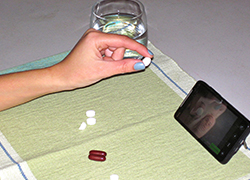Monitoring Tuberculosis Treatment with Mobile Phones
Researchers: Richard S. Garfein (UC San Diego) and Fatima Munoz
Location: Mexico
 Tuberculosis (TB) is an airborne bacterial disease that remains a global health threat affecting more than two billion people—one-third of the world’s population—and is one of the three leading causes of death worldwide due to infectious diseases.
Tuberculosis (TB) is an airborne bacterial disease that remains a global health threat affecting more than two billion people—one-third of the world’s population—and is one of the three leading causes of death worldwide due to infectious diseases.
TB can be effectively treated with antibiotics, but better tools are needed to improve compliance for treatment regimens which last for longer than six months. Otherwise, the illness progresses, TB transmission continues, and bacteria can become drug-resistant.
To obtain high adherence and prevent drug resistance, health agencies recommend directly observed therapy (DOT) to monitor patients taking each dose of medication; however, DOT is labor and cost intensive, requires transportation, restricts patient mobility, and may not be used when patients live far from health centers.
A solution developed by researchers at UC San Diego’s Division of Global Public Health and programmers at the Qualcomm Institute allows patients to use smartphones to make and send videos of each medication dose taken, which health workers watch from their office using a secure website.Through this quick, simple process, care providers can focus their efforts on non-adherent patients.
In 2010–2012, the Video Directly Observed Therapy (VDOT) monitoring system was pilot tested with 43 patients in San Diego and nine patients in Tijuana. Researchers found that VDOT was feasible: more than 93 percent of expected doses were observed using VDOT.
Increased adherence to TB treatment as a result of VDOT has significant public health benefits. While TB incidence overall has declined in the United States, the proportion of foreign-born cases has increased, and 47 percent of all foreign-born cases in San Diego were from Mexico. The US–Mexico border is not a barrier to TB transmission, and TB incidence in the San Diego region is many times higher than the national averages in both countries.
Results
PDEL funded work to customize the VDOT software so that it works reliably and securely in the Mexican environment. The team also established operational protocols in Spanish and developed data collection instruments needed for a larger pilot study comparing VDOT to traditional in-person DOT among TB patients at the two largest providers of health care for TB cases in Tijuana: the Mexican Institute of Social Security (IMSS) and the Institute of Health Services (ISESALUD).
The results of the current work and subsequent pilot study could change policies at IMSS and ISESALUD to allow implementation of VDOT in Baja California and possibly the rest of Mexico.
Related Publications
Garfein, R. S., K. Collins, F. Muñoz, K. Moser, P. Cerecer-Callu, F. Raab, P. Rios, A. Flick, M. L. Zúñiga, J. Cuevas-Mota , K. Liang, G. Rangel, J. L. Burgos, T. C. Rodwell, and K. Patrick. 2015. "Feasibility of Tuberculosis Treatment Monitoring by Video Directly Observed Therapy: A Binational Pilot Study." International Journal of Tubercular Lung Disease (9):1057-64. doi: 10.5588/ijtld.14.0923.
Story, A., R. S. Garfein, A. Hayward, V. Rusovich, A. Dadu, V. Soltan, A. Oprunenco, K. Collins, R. Sarin, S. Quraishi, M. Sharma, G. B. Migliori, M. Varadarajan, and D. Falzon. 2016. "Monitoring Therapy Compliance of Tuberculosis Patients by Using Video-enabled Electronic Devices." Emerging Infectious Diseases 22 (3): 538–40.
UC San Diego Health. 2013. VDOT Technology Eases Monitoring for Patients with Tuberculosis. Video. September 3.

